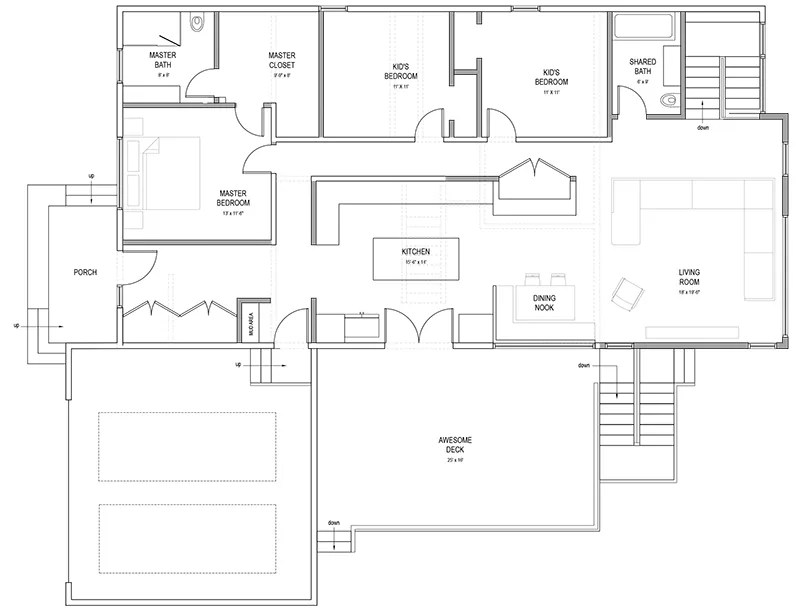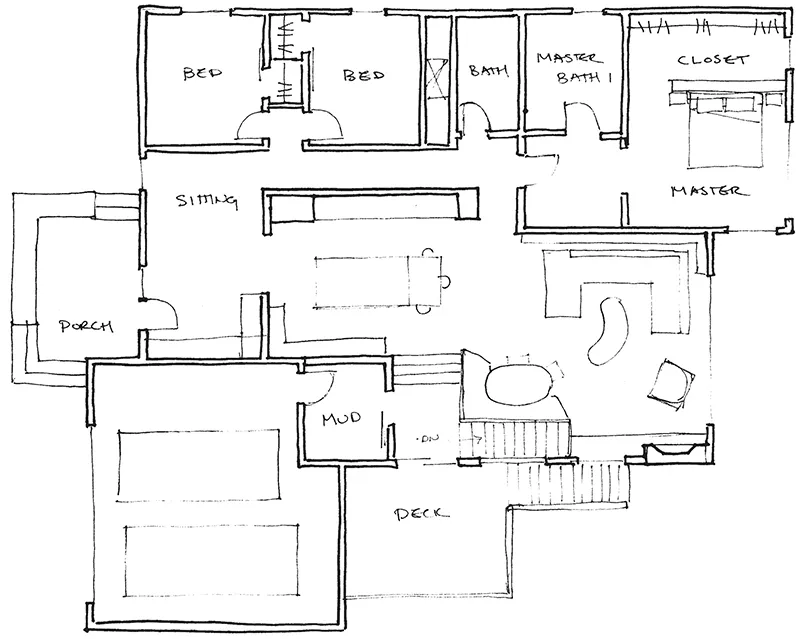Fixing a not-so-good house layout is like putting together a puzzle to make your home better. First, look around and figure out what things bug you the most, like cramped spaces or weird setups. Talk to pros like designers or architects for good advice. Make rooms feel bigger by taking down walls that don’t hold up the house. Check if people can move around easily, and think about where doors should go. Let more sunlight in and update the floors for a cozy home. Divide big spaces with furniture to make different areas.
Furthermore, keep things tidy with lots of smart storage. Mix looks with usefulness when arranging furniture. Think ahead for changes in your life and be flexible in how you set up your home. Remember, your home is special, so get creative to find what works best for you!
How to identify layout issues effectively?

By systematically analyzing and prioritizing these issues, you can develop a roadmap for addressing the most critical aspects of your home’s layout.
Identifying Specific Issues within the Current Layout
Room-by-Room Analysis: Conduct a thorough walkthrough of your home, examining each room individually. Identify aspects that feel uncomfortable, cramped, or awkward. Pay attention to issues related to flow, lighting, and overall functionality.
User Feedback: Gather input from family members or occupants. Different perspectives can reveal aspects of the layout that may not be immediately apparent. Discuss how each space is currently used and any frustrations or limitations experienced.
Prioritizing Concerns Based on Impact and Urgency
Impact on Daily Life: Consider how each identified issue affects your daily routines and activities. A cramped kitchen may impact meal preparation, while a poorly designed living room might affect family time. Prioritize issues that directly impact the quality of your daily life.
Urgency and Long-Term Goals: Evaluate the urgency of addressing each issue. Some problems may require immediate attention, such as safety concerns or structural issues. Simultaneously, consider long-term goals and how addressing certain issues now can contribute to a more efficient and enjoyable living space over time.
Cost Considerations: Assess the financial implications of addressing each concern. Some fixes may be more budget-friendly, while others might require a larger investment. Balance the importance of the issue with your budget constraints to determine the order of priority.
Example Scenario
- Identified Issue: The current layout features a closed-off kitchen that hinders interaction during meal preparation.
- Impact: This negatively affects family bonding and makes the kitchen feel isolated.
- Urgency: While not urgent, addressing this issue aligns with a long-term goal of creating a more social and connected living space.
- Cost Consideration: Opening up the kitchen might involve removing a non-load-bearing wall, making it a moderate investment.
What are practical space-opening solutions?
By implementing these practical solutions, you can transform the functionality and aesthetics of your home’s layout, addressing specific issues identified during the assessment phase.
Opening Up Spaces
Non-load-bearing walls are those that don’t support the structure of the house. Removing them can open up confined spaces, creating a more open and spacious feel.
Consult with a structural engineer to identify load-bearing walls and ensure the removal of non-load-bearing walls won’t compromise the integrity of the structure. This solution is particularly effective in connecting areas like the kitchen, dining, and living rooms.
Improving Traffic Flow
Doors can impact the flow between rooms. Repositioning them strategically can enhance movement and make the layout more intuitive.
Identify high-traffic areas and ensure doors don’t obstruct these pathways. Consider pocket doors or barn doors for spaces where traditional swinging doors may be impractical. This solution aims to improve both convenience and accessibility.
Maximizing Natural Light
Natural light contributes to a welcoming and spacious atmosphere. Enhancing window placement and using effective lighting design can transform the feel of a space.
Assess the orientation of your home to maximize natural light. Use lighter window treatments to allow more light in. Incorporate a mix of ambient, task, and accent lighting to create a well-lit and visually appealing environment.
Updating Flooring
Flooring is a foundational element that ties together the visual appeal of a space. Updating flooring materials and designs can contribute to a cohesive and harmonious aesthetic.
Choose flooring materials that complement the overall design theme. Consistency in flooring throughout connected spaces can create a seamless transition. Consider factors like durability, maintenance, and comfort when selecting flooring options.
Example Scenario
- The living room feels cramped and lacks natural light.
- Removing a non-load-bearing wall between the living room and adjacent room to create an open layout.
- Repositioning the door to the backyard to improve traffic flow and connection to outdoor spaces.
- Enhancing natural light by installing larger windows and using strategic lighting fixtures.
- Updating the flooring to a lighter material to create a cohesive and brighter aesthetic.
How to define zones using furniture?
By focusing on functionality and organization, you can tailor your home’s layout to better suit your lifestyle, creating designated spaces for different activities and implementing effective storage solutions to keep the space tidy and enjoyable.
Defining Functional Zones
Defining functional zones within a space ensures that each area serves a specific purpose. Furniture and design elements play a crucial role in visually separating and organizing different functions.
Use area rugs, furniture placement, and lighting to delineate zones. For example, in an open living space, strategically position furniture to create distinct areas for lounging, dining, and work. This approach enhances the overall functionality and visual appeal of the space.
Ensuring Ample and Well-Designed Storage
Strategies to Prevent Clutter: Effective storage solutions are essential for maintaining an organized and clutter-free home. Strategic storage prevents items from piling up, contributing to a more functional and visually pleasing environment.
Considerations
- Built-in Storage: Integrate built-in shelves, cabinets, and closets to maximize available space.
- Multi-functional Furniture: Choose furniture that serves dual purposes, such as ottomans with hidden storage or beds with built-in drawers.
- Decluttering Systems: Implement organizational systems, such as baskets, bins, and shelving units, to keep items in order.
- Regular Purging: Schedule regular decluttering sessions to eliminate unnecessary items and maintain an efficient use of space.
Example Scenario
The home lacks clearly defined areas for various activities, and clutter accumulates quickly.
Solutions
- Use furniture arrangement and area rugs to create distinct zones for work, relaxation, and dining within an open living space.
- Integrate built-in storage solutions like bookshelves or cabinets to keep belongings organized.
- Choose furniture pieces with hidden storage to minimize visible clutter.
- Implement a regular decluttering routine to maintain an organized and functional home.
How to balance visual appeal and functionality in furniture arrangement?

Balancing aesthetics with practicality in furniture arrangement requires thoughtful consideration of the room’s purpose and the needs of its occupants.
Experimenting with Furniture Arrangement
The arrangement of furniture significantly influences both the visual aesthetics and the practical functionality of a space. Striking the right balance ensures that the layout is not only pleasing to the eye but also serves its intended purpose effectively.
Considerations
- Traffic Flow: Arrange furniture to facilitate easy movement through the space. Avoid blocking natural pathways.
- Focal Points: Identify and highlight focal points, such as a fireplace or a scenic view, by orienting furniture accordingly.
- Conversation Areas: Create cozy conversation areas by arranging seating in a way that encourages interaction.
- Multifunctional Furniture: Use furniture that serves multiple purposes to maximize functionality without sacrificing aesthetics.
Example Scenario
The living room feels cluttered, and the furniture arrangement does not make the best use of the available space.
Solutions
- Experiment with different furniture layouts to find the most efficient arrangement that allows for easy movement and emphasizes the room’s focal points.
- Consider using versatile and modular furniture pieces that can adapt to different needs and configurations.
- Create distinct conversation areas by arranging seating around a central point, such as a coffee table or fireplace.
- Ensure that the chosen arrangement complements the overall design theme of the space.
Final Words
Fixing a not-so-good house layout is a bit like solving a puzzle to make your home nicer. We’ve figured out how to spot problems, get advice from experts, and make practical changes, like opening up rooms and making it easier to move around. Making sure there’s lots of natural light and updating the floors can make things extra comfy. We also chatted about organizing spaces with smart furniture and having enough storage to keep things tidy.
In addition, it’s important to make things look good and work well, and trying out different furniture setups can really help. Plan for the future and be ready for changes. Just remember, your home is special, so be creative and find what makes it the best for you!
